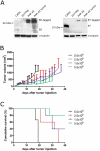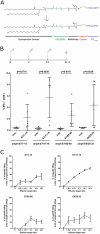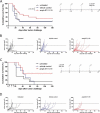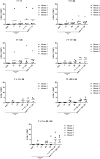Therapeutic vaccination using minimal HPV16 epitopes in a novel MHC-humanized murine HPV tumor model
- PMID: 30546964
- PMCID: PMC6287800
- DOI: 10.1080/2162402X.2018.1524694
Therapeutic vaccination using minimal HPV16 epitopes in a novel MHC-humanized murine HPV tumor model
Abstract
Therapeutic vaccination as a treatment option for HPV-induced cancers is actively pursued because the two HPV proteins E6 and E7 represent ideal targets for immunotherapy, as they are non-self and expressed in all tumor stages. MHC-humanized mice are valuable tools for the study of therapeutic cancer vaccines - given the availability of a suitable tumor model. Here, we present for the first time an HPV16 tumor model suitable for fully MHC-humanized A2.DR1 mice, PAP-A2 cells, which in contrast to existing HPV16 tumor models allows the exclusive study of HLA-A2- and DR1-mediated immune responses, without any interfering murine MHC-presented epitopes. We used several HPV16 epitopes that were shown to be presented on human cervical cancer cells by mass spectrometry for therapeutic anti-tumor vaccination in the new tumor model. All epitopes were immunogenic when rendered amphiphilic by incorporation into a molecule containing stearic acids. Prophylactic and therapeutic vaccination experiments with the epitope E7/11-19 demonstrated that effective immune responses could be induced with these vaccination approaches in A2.DR1 mice. Interestingly, the combination of E7/11-19 with other immunogenic HPV16 E6/E7 epitopes caused a reduction of vaccine efficacy, although all tested combinations resulted in a survival benefit. In summary, we present the first HPV16 tumor model for exclusive studies of HLA-A2-mediated anti-HPV tumor immune responses and show anti-tumor efficacy of minimal epitope vaccines.
Keywords: A2.DR1; Cancer immunotherapy; HLA-humanized mouse model; PAP-A2; human papillomavirus (HPV); therapeutic vaccination.
Figures






Similar articles
-
Inducing Immunity Where It Matters: Orthotopic HPV Tumor Models and Therapeutic Vaccinations.Front Immunol. 2020 Aug 14;11:1750. doi: 10.3389/fimmu.2020.01750. eCollection 2020. Front Immunol. 2020. PMID: 32922389 Free PMC article. Review.
-
Identification of the murine H-2D(b) and human HLA-A*0201 MHC class I-restricted HPV6 E7-specific cytotoxic T lymphocyte epitopes.Cancer Immunol Immunother. 2016 Mar;65(3):261-71. doi: 10.1007/s00262-016-1793-x. Epub 2016 Jan 13. Cancer Immunol Immunother. 2016. PMID: 26759151 Free PMC article.
-
Identification of HLA-DR1- and HLA-DR15-restricted human papillomavirus type 16 (HPV16) and HPV18 E6 epitopes recognized by CD4+ T cells from healthy young women.J Gen Virol. 2007 May;88(Pt 5):1470-1478. doi: 10.1099/vir.0.82558-0. J Gen Virol. 2007. PMID: 17412975
-
Human CTL epitopes encoded by human papillomavirus type 16 E6 and E7 identified through in vivo and in vitro immunogenicity studies of HLA-A*0201-binding peptides.J Immunol. 1995 Jun 1;154(11):5934-43. J Immunol. 1995. PMID: 7538538
-
Anti-Cancer Vaccine for HPV-Associated Neoplasms: Focus on a Therapeutic HPV Vaccine Based on a Novel Tumor Antigen Delivery Method Using Endogenously Engineered Exosomes.Cancers (Basel). 2019 Jan 24;11(2):138. doi: 10.3390/cancers11020138. Cancers (Basel). 2019. PMID: 30682811 Free PMC article. Review.
Cited by
-
Development of an Orthotopic HPV16-Dependent Base of Tongue Tumor Model in MHC-Humanized Mice.Pathogens. 2023 Jan 25;12(2):188. doi: 10.3390/pathogens12020188. Pathogens. 2023. PMID: 36839460 Free PMC article.
-
Robust anti-tumor T cell response with efficient intratumoral infiltration by nanodisc cancer immunotherapy.Adv Ther (Weinh). 2020 Sep;3(9):2000094. doi: 10.1002/adtp.202000094. Epub 2020 Jun 23. Adv Ther (Weinh). 2020. PMID: 38317797 Free PMC article.
-
Development and evaluation of a novel E7 multi-epitopic vaccine for human papillomavirus type 16: design, expression, purification, and immunological characterization.BMC Infect Dis. 2025 Feb 5;25(1):174. doi: 10.1186/s12879-024-10343-x. BMC Infect Dis. 2025. PMID: 39910471 Free PMC article.
-
Inducing Immunity Where It Matters: Orthotopic HPV Tumor Models and Therapeutic Vaccinations.Front Immunol. 2020 Aug 14;11:1750. doi: 10.3389/fimmu.2020.01750. eCollection 2020. Front Immunol. 2020. PMID: 32922389 Free PMC article. Review.
-
Papillomavirus Immune Evasion Strategies Target the Infected Cell and the Local Immune System.Front Oncol. 2019 Aug 2;9:682. doi: 10.3389/fonc.2019.00682. eCollection 2019. Front Oncol. 2019. PMID: 31428574 Free PMC article. Review.
References
-
- Hildesheim A, Gonzalez P, Kreimer AR, Wacholder S, Schussler J, Rodriguez AC, Porras C, Schiffman M, Sidawy M, Schiller JT, et al. Impact of human papillomavirus (HPV) 16 and 18 vaccination on prevalent infections and rates of cervical lesions after excisional treatment. Am J Obstet Gynecol. 2015;215:212.e1–212.e15. - PMC - PubMed
-
- Walker TY, Elam-Evans LD, Singleton JA, Yankey D, Markowitz LE, Fredua B, Williams CL, Meyer SA, Stokley S. National, regional, state, and selected local area vaccination coverage among adolescents aged 13–17 years — united States, 2016. MMWR Morb Mortal Wkly Rep. 2016;66:874–882. doi:10.15585/mmwr.mm6633a2. - DOI - PMC - PubMed
Publication types
LinkOut - more resources
Full Text Sources
Other Literature Sources
Molecular Biology Databases
Research Materials
